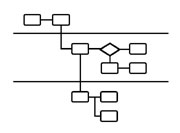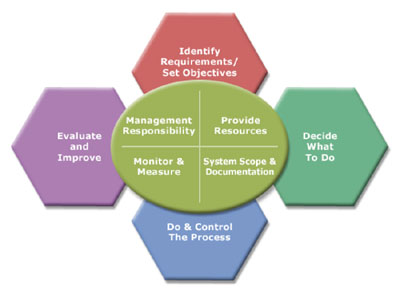

1.Understand the Use of a Process-Based Approach
Figure 1 shows the essential difference between the procedure-based approach used in the 1994 standard and the process-based approach used in ISO 9001(2000).The procedure-based approach of the 1994 standard tends to reinforce separations between departments and functions in the company. It’s often hard to see how everything works together. “Improvement” in one area may result in problems in another. For example, faster approval of customers by deleting a credit check may result in financial problems; saving a week in design by limiting prototype testing may result in production problems and customer returns later on.
In contrast, the new standard actually allows you to structure your system (and your documentation) around the needs of your business, not just the requirements of the standard.
Let’s look at a specific example from the receiving area of a company. It is common to find this process carved up into a number of separate procedures based on the sections of the 1994 standard, including:
- Incoming inspection,
- Customer-supplied material,
- In-process inspection (for materials sent out for secondary processing),
- Inspection and test status,
- Identification and traceability,
- Process control,
- Storage and handling, and
- Handling of non-conforming material.
Using a process-based approach, you view activities in a more realistic fashion. You work with an interconnected set of activities potentially involving multiple functions in the organization, and you identify the activities, decisions and controls required to get the best results. See Figure 2.

2.Educate Top Management on Difference/Benefits
You’re probably already familiar with the “Document what you do, and do what you document” summary of the 1994 standard. A similarly abridged version of the 2000 standard would read, “Identify, document and implement processes that work together to meet customer requirements – and continually improve those processes.”Benefits to your business from using this process-based approach include:
- Systematic elimination of “sand in the gears,”
- Faster implementation of change with fewer mistakes,
- Lower costs and faster response times, and
- Reliable achievement of desired business results.
3.Train Auditors in Revisions and Auditing of Process-Based Systems
There are numerous changes introduced by the ISO 9001(2000) standard. Most of these are driven by a few key principles:- Use of a process-based approach,
- Increased focus on meeting customer requirements,
- Leadership and involvement, and
- Achieving continual improvement.

4.Train Managers and Supervisors in Process-Based Approach
A few key people need training in the full depth of the ISO 9001(2000) standard itself, which may take several days. This type and amount of training do not provide a clear benefit for the management and supervisory group. However, more condensed training that develops understanding of the key principles and their application in everyday work provides significant benefits. These benefits include improved participation, more effective transition and use of the principles to achieve the continual improvement required by the standard.5.Train Employees in Process-Based Approach
An employee directly involved in doing a particular job every day has insights into that job that are not available elsewhere. In their day-to-day work, people regularly see opportunities for improvement, but the threshold of effort to pursue these opportunities is too high. So employees live with the problems and don’t pursue the opportunities, or do local workarounds (unknown and undocumented, of course). You lose understanding of how your systems and processes actually work, and access to experience and expertise that would increase the success of your business.The process-based approach lowers the threshold of effort to obtain employee input by mapping the activities and decisions with all of the interactions that are part of the process. Several major benefits result from this mapping:
- Lower threshold of effort for making changes;
- Elimination of duplicate and unnecessary activities;
- Encouraging people to contribute ideas;
- Focus on how things work together (the process), not on the documentation; and
- Understanding of how the whole system works, not just the pieces.
These are key benefits available from implementing the process-based approach now incorporated in the new ISO 9001(2000) standard.
Get Everyone Trained
Training people in the process-based approach is key to unlocking the benefits. How do you train everyone in an organization quickly and effectively in a cost-constrained business environment? Web-, intranet- or computer-based training offer significant advantages:- Reaches large numbers of people quickly,
- Reaches geographically dispersed employees quickly,
- Saves time in development and delivery,
- Available 24/7 to suit manager and employee schedules,
- Avoids the business disruption of classroom training, and
- Provides testing and record keeping to meet ISO requirements.
Case Histories
Here are some examples of how we helped organizations understand and apply a process-based approach.6.Apply Process-Based Approach – Simplify System/Improve Results
Use the process-based approach to re-examine how the various parts of your business work together. Process mapping, while not specifically required by the standard, is a useful tool for implementing a process-based approach. Developing the process map helps capture information that might otherwise be lost. The map also aids in developing a common understanding among all involved about how processes actually work.
Process-based systems are easier to understand and improve. They help you develop common objectives among multiple activities. They also simplify system documentation and maintenance.
Continual Improvement
Continual improvement is a new requirement in the 2000 standard. You must be able to demonstrate continual improvement in your processes and substantiate the effectiveness of your quality-management system.Use of a process-based approach makes it easier to achieve continual improvement. You develop a better understanding of how your systems and processes work, and the methods and controls needed to support them. With this understanding, you can make more effective use of tools — such as root-cause analysis and problem-risk analysis — and prevention tools such as Failure Mode & Effects Analysis (FMEA).
Understanding the process is a key starting point and an ongoing implementation tool for many of these techniques. The other critical element for achieving the necessary results is the involvement of your employees. With a process-driven focus in the organization, more people have the ability to make more effective use of these tools.
7.Audit and Review Your System
Audit and review your system to confirm operations, hold the gains achieved and identify further opportunities for improvement.8.Registrar Audit for Certification to ISO 9001(2000)
Using a process-based approach is worth the effort. With a quality-management system better aligned with your business processes, there is no need for heavy scrambling to bring your system “back in line” before an audit.You also can make the audits pay for themselves. Here’s an example from one of our clients.
December 15, 2003, the required date for re-certification to be complete, is rapidly approaching. Following these eight steps will help you achieve re-registration before this critical date.
